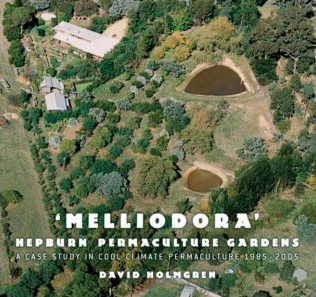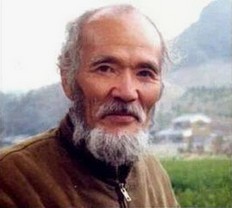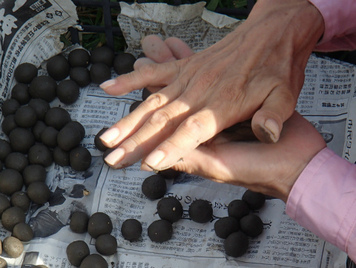Content
1. Transforming a farm to its origins -
pioneer
Masanobu Fukuoka in Japan (1938)
2. Permaculture of the Alps (high mountains):
pioneer Sepp Holzer with his farm
Krameterhof Austria (since the 1960s)
3.
The Permaculture Research Institute in
Australia: Zaytuna Farm by Geoff + Nadia Lawton
(1978/1997)
4.
The permaculture garden research project
"Melliodora" in Australia by David Holmgren
(1985)
5. Permaculture farm of the
Hervé-Gruyer
family in Le Bec Hellouin, France (since
2004/2008)
6. Project 63 at farm of
Owl Farm
(Eulenhof) in Möhlin (CH) (2018)
Here are some big pioneers - in terms of organic farming
with permaculture - almost NO machines, WITHOUT
pesticides, almost WITHOUT irrigation:
1. Transforming a Farm to its origin -
pioneer Masanobu Fukuoka in Japan (1938)
Masanobu
Fukuoka, portrait [1] - Masanobu Fukuoka's
book: One Straw Revolutionary (1984) [2] -
Amazon Link
Fukuoka, the seed balls [3] -
The citrus garden of Masanobu Fukuoka [4]
Masanobu Fukuoka was born on Feb. 2, 1913 on the
island of Shikoku (South Japan) [web02], in
Ehime [web04] and grew up in an aristocratic
family, made a career in agricultural science
[web02] and was the agricultural customs
inspector in Yokohama working with the
microscope [web04]. During a pneumonia in 1937
came his turning point, the knowledge about the
criminal machine agriculture [web02] and the
knowledge about the original agriculture with
the unity of tree, shrub, stone, plants and
animals [web05]. He returned to his family in
southern Japan and from 1938 onwards changed a
farm to its original principles, with rice
fields and with a garden of mainly citrus fruits
(citrus garden) [web02].
Masanobu Fukuoka: Back to
originality
-- "Shizen noho" means natural farming in
Japanese
-- Fukuoka was one of the five great pioneers of
organic farming, alongside with Rudolf Steiner
(Austria), Lady Eve Balfour (GB), J.I. Rodale
("USA").
-- There is not much work, but nature has to be
arranged so that a farmer has virtually no work:
no tillage, no weeding, no pruning, no
fertilization, no pesticides use
-- The farm of Masanobu Fukuoka hardly needs
resources and hardly any equipment
-- The seed balls are an old Japanese technique
of sowing vegetables directly [web04].
Data:
Fukuoka with his nothing to do landscape (Daoist
Wu-wei principle): Fukuoka invented the "seed
balls" (no-plow direct-sowing method) -
Principle: Nature is able to sustain itself -
there is a wild combination of plants for an
ecological balance - protecting crops from pests
- the soil continues to enrich with nutrients -
fields and gardens are with many animals and
plants, no plowing or chemical fertilization is
necessary - fertilization and protection against
pests are done by nature itself knowning where
to let it be and knowing how - the agricultural
area for humanity will decrease with this
method, because per m2 much more grows - the
food becomes seasonal adapted, and one should
not eat much meat - there is double crop
rotation without any plow: Rice is planted first
and winter barley is planted second alternately
- white clover to control weeds -- white clover
is for nutrient supply - 1988 he gest the Ramon
Magsaysay Prize - then comes the book "One Straw
Revolution" [web01].
The goal of Masanobu Fukuoka: Formerly 12,000
years ago, the entire earth was a forest garden
with waters everywhere, and this wild and
naturally fertile state can be restored [web05].
Deforestation and irrigated agriculture with
monocultures are not the truth, it is much
easier by returning to the orchard respectively
to the forest garden, as it existed 12,000 years
ago [web05].
Man is only a visitor in nature - says Fukuoka.
Things that need a lot of human work are always
automatically questioned by Fukuoka in order to
find easier ways. Because nature can do many
things ONLY if you restore the original nature:
insect control, fertilization, irrigation, etc.
Things that do not work must be left out and an
easier way has to be chosen [web05]. [The
solution will eventually come later].
Masanobu Fukuoka restored the natural conditions
with light fruit trees, shrubs and planting
beds. He made a seed mixture, rolled the seeds
into clay balls and distributed these seed clay
balls ("seed bombs") in the garden. Then he let
nature decide where to grow the best and had
nothing more to do except add some compost at
the beginning when there was too little mulch
from the trees.
Therefore he could accumplish and put into
practice the following:
1. Abolishing fertilization: Plants with long roots
improve the soil - and strengthen the other plants
The orchard was changed: The soil was stabilized with
clover and plants with deep roots: daikon, burdock,
dandelion, etc. So the soil was enriched. He also sowed
radish, mustard, buckwheat, alfalfa, cereals and perennial
brushes, and he planted various tree species. The soil
improved in a short time, so Fukuoka could do all his
natural agriculture without any fertilizer [web05].
2. Abolish pesticides: let trees grow, theis is the
habitat of beneficial insects
Because there was no habitat for many of the insects,
Fukuoka first had to make a natural insecticide such as
pyrethrum from chrysanthemum roots, which he sprayed on
his vegetables to keep things like cabbage worms and
cabbage moths away. But after creating the habitat with
many different insects, the natural balance was created
and no manual fight against insects was necesary any more
[web05].
The 5 principles of Fukuoka
1. Plowing or tilling is not required, no engine machines
2. No fertilizers, no compost
3. No weeding, no pesticides, only minimal weed control
4. No pesticides, no herbicides
5. No pruning of fruit trees [web02].
more
2. Reshaping a farm - example of pioneer
Sepp Holzer at his farm "Krameterhof" near Salzburg,
Austria (since the 1960s)

The farm Krameterhof of Sepp Holzer in Austria [5]
Krameterhof
Keusching 13,
5591 Ramingstein,
Austria
TEL + FAX 0043 6475 239
EMAIL office@krameterhof.at
Web site:
www.krameterhof.at
There are workshops and events without end there at this
farm Krameterhof -
Link.
Book: "Sepp Holzer - the agrarian rebel" (original German:
"Sepp Holzer - der Agrarrebell")
Video: Der Agrar-Rebell. Permakultur in den Salzburger
Alpen
Basic principles of Holzer:
-- "Diversity instead of simplicity, because all animals
and plants have a meaningful function"
-- "Cooperate with nature instead of fighting it. Observe
nature and find out which plants support each other"
[web03]
On the farm of Sepp Holzer in the Alps at 900 to 1400m
altitude, there is an annual average temperature of 4.5
degrees Celsius [about 41º Fahrenheit]. Holzer observed
nature for more than 40 years, experimenting and creating
an ecosystem that resembled an "edible paradise landscape"
installing "diversity instead of simplicity". He found out
which plants support each other. The authorities, however,
found that Holzer would not comply with standards and
provoked processes that increased Holzer's profile.
This development is described in the book "Sepp Holzer:
The Agrarian Rebel" (original German: Sepp Holzer: Der
Agrar-Rebell" [web03].
Amazon
link
-- First Mr. Holzer arranged the landscape of his farm
Krameterhof with big machines installing new ponds, hills
and wind-friendly zones [web08]
-- Sepp Holzer grows kiwis on his mountain farm, cherries,
pumpkins, radishes - cereals grow in the forest
-- He has a minimum workload with maximum yield
-- For water supply, fishponds and frog pools were created
-- Pigs and chickens roam freely and eat [in demarcated
areas]
-- Medicinal plants and hillbeds are standard
-- Sepp Holzer is a frequent consultant for projects, also
overseas in Colombia, Ecuador and Brazil, where leached
soils are transformed back into agricultural land with the
help of permaculture
-- Criminal NWO authorities in Austria wanted to prevent
the new permaculture agriculture of Holzer, but they did
not succeed. [Web04]
-- Pigs are plowing the fields
-- With cleverly combined mixed plantings there is NO need
for fertilizers
-- Fish farming is possible with sophisticated ponds
-- Amphibians and birds regulate harmful insects [web06]
-- Chickens and pigs eat slugs / nudibranchs in the
vegetable garden [web08]
Permaculture pioneer Sepp Holzer and wife Veronika Holzer
ran her farm Krameterhof until 2009 and have changed to
lower region of Austria to Burgenland ("Castle Country")
since 2012 with their pension. The Krameterhof is
continued by the son Josef A. Holzer [web05].
more
[web03]
http://www.agenda21-treffpunkt.de/archiv/03/11/SeppHolzer.htm
[web04]
https://www.amazon.de/Agrar-Rebell-Sepp-Holzer/dp/3702009701/ref=sr_1_1?s=books&ie=UTF8&qid=1538588625&sr=1-1&keywords=agrar-rebell
[web05] http://www.krameterhof.at/cms60/index.php?id=5
[web06]
https://www.amazon.de/Agrar-Rebell-Sepp-Holzer/product-reviews/3702009701/ref=cm_cr_dp_d_show_all_btm?ie=UTF8&reviewerType=all_reviews
[web08]
https://www.amazon.de/Agrar-Rebell-Sepp-Holzer/product-reviews/3702009701/ref=cm_cr_getr_d_paging_btm_3?ie=UTF8&reviewerType=all_reviews&pageNumber=3
3. The Permaculture Research Institute in
Australia: Zaytuna Farm by Geoff Lawton and Nadia Lawton
(1978/1997)


Permaculture Research Institute Zaytuna Farm of Geoff
and Nadia Lawton, Australia [6] - The Plan [7]
Link of the Permaculture Research Institute near Brisbane,
Australia:
https://zaytunafarm.com/about-us/
Address: Zaytuna Farm - 1158 Pinchin Road - The Channon -
NSW 2480 - Australia
E-mail:
education@zaytunafarm.com
- Tel.
+61 (0) 416119965 -
office times: Mo-Fr
E-form:
https://zaytunafarm.com/contact-us/
Forerunner Bill Mollison with the Tagari Farm
The predecessor of the Permaculture Research Institute on
the Zaytuna Farm was the Permaculture Research Institute
on the Tagari Farm (1978) headed by Bill Mollison [web29].
Geoff Lawton took over the Permaculture Research
Institute - and moved it to the Zaytuna Farm
In 1997, Bill Mollison handed over the Permaculture
Research Institute to his permaculture student Geoff
Lawton, who has since held the leadership with his wife
Nadia. He moved the institute to Zaytuna Farm. Geoff
Lawton got his Permaculture Certificate (PDC) from Bill
Mollison in 1983 and since 1985 he is an ambassador of
permaculture around the world to over 50 countries with
courses and counseling to restore ecosystems [web10].
The 27-acre Zaytuna Farm is located on the Teraniabach
(Terania Creek) opposite the village of "The Channon" in
northwest Australia near Brisbane. The farm is an
excellently designed permaculture farm and produces many
food items itself. The brook bank is 800m long, with
numerous bathing sites and a rich wildlife. The landscape
includes high, frost-free hills, ridges, valleys, wooded
areas, etc. There is ongoing work on development and soil
research to develop more efficient and productive
ecosystems [web10].
The Zaytuna farm has solar power, irrigation systems with
private pond water, biogas plant with greywater system,
composting toilets, student containers with student
kitchen, chickens, ducks, quails, turkeys, rabbits, fish
and dairy cows, gentle tillage with increasingly fertile
soil, perennials with forest garden (food forest), shrubs,
vines and herbs, fruits and nuts, family flats [web10].
more
[web10] https://zaytunafarm.com/about-us/
[web29] Bill Mollison:
https://de.wikipedia.org/wiki/Bill_Mollison
4. The permaculture garden research
project "Melliodora" in Australia by David Holmgren
(1985)
The permaculture garden site of
"Melliodora" (Melliodora Gardens) by David Holmgren and
Su Dennett in Hepburn Springs (Australia) [8] - the plan
[9]

Holmgren Design, logo [10]
In 1985, David Holmgren and Su Dennett transformed a
barren, one-hectare piece of blackberry overgrown land
into a small intensive permaculture facility [web12] - in
Hepburn Springs, north of Melbourne, Australia [web13].
The "Melliodora Gardens" (Melliodora Hepburn Permaculture
Gardens) by David Holmgren and Su Dennett are a
permaculture study garden for colder climates and show the
relationships for small farms and large blocks of flats
[web11].
Meliodora has a passive house, mixed vegetable gardens,
orchards, dams and livestock. Also renaturation of creeks
is shown. The Melliodora horticultural model is most
relevant for big city blocks and allotments. In workshops
and tours the basic principles and strategies are
presented. Website with course offers and contact form
Link
[web12]. E-mail: info [at] holmgren [dot] com [dot] au
For its 20th anniversary, a book with the case studies of
Melliodora came out -
Link
[web11].

Book by Holmgren on the 20th anniversary of Melliodora
[11]
[web11]
https://store.holmgren.com.au/product/melliodora/
[web12] https://holmgren.com.au/melliodora/tours/
[web13] https://en.wikipedia.org/wiki/David_Holmgren
Buch von Perrine Hervé-Gruyer über das neue Leben
mit Permakultur: La relaxation en famille - Amazon-Link
Buch über die Erfahrungen und Lernprozesse mit der
Permakultur [web02]: Permaculture
– Guérir la Terre, nourrir les Hommes
- Amazon-Link
(Permakultur - die Erde heilen, die Leute
ernähren)
5. Transforming a Farm -
permaculture farm of Hervé-Gruyer family in Le
Bec Hellouin, France (since 2004/2008)
2004
France: Foundation of the farm in Bec Hellouin
- starting in 2008 with permaculture
Website of the Permaculture Farm: https://www.fermedubec.com/
Charles Hervé-Gruyer wrote a book about his
experiences as sailing teacher sailing around the
world and his encounterings with native people: La
femme feuille - Amazon
link
Mrs. Perrine Hervé-Gruyer wrote a book about new
life with permaculture: La relaxation en famille -
Amazon
link
And in 2018 a new book came out: Permaculture
- healing the earth, feeding people
(original French:
Permaculture - Guérir la Terre, nourrir les
Hommes) - Amazon
Link
Farm in "Le Bec Hellouin"
in France, Charles Hervé-Gruyer explains
the hillbed principle, scheme [12] - The
hillbeds of the permaculture farm in "Le
Bec Hellouin" form a large mandala, a
mandala field, aerial view [13]
In 2004, Charles Hervé-Gruyer and Perrine
Hervé-Gruyer took over a farm in the
village of Bec Hellouin, to feed their
children with good vegetables and fruits.
In 2006 they made the Farmers Diploma.
Before Charles had a sailing school and
had traveled around the world with his
school sailing ship for 20 years, meeting
natives around the world (Amazon Jungle,
Africa, Papuans, Aboriginal, etc.),
getting to know their lives in harmony
with nature, making movies and books
edited about them, among others the book
"La femme feuille". The Permaculture Farm
is inspired by the spirit of the
indigenous people with their lives in
harmony with nature. His wife Perrine had
turned away from top sport and being a
business woman saying good bye to
capitalist life returning to nature. She
advises more permaculture farms. On
further education they discovered
permaculture and elements of Eliot Coleman
and changed their farm 2008 to
permaculture [web01].
The transforming process took place with a
mandala garden, with garden islands, and
with an orchard forest (garden forest) -
with forest gardening and hill farming.
Yields increased, and agronomists and
gardeners began to admire this farm in Bec
Hellouin. The development was
scientifically accompanied. The National
Institut for Agriculture Research (institut
national de la recherche agronomique)
and the Technical Agricultural Institute
AgroParisTech confirmed the large yields
in a small space. The farm became a large
family with many employees. The
experiences are described in the book of
2018 "Permaculture
- healing the earth,
feeding people" (original
French:
Permaculture
– Guérir la Terre, nourrir les
Hommes
[web01].
more
[web01]
https://www.fermedubec.com/la-ferme/lhistoire-de-ferme/
[web02]
https://www.amazon.fr/Permaculture-Guérir-terre-nourrir-hommes/product-reviews/2330074166/ref=dpx_acr_txt?showViewpoints=1
6. Transforming a farm according to permaculture -
Example Project 63 at the "Owl farm" (German:
"Eulenhof") in Möhlin (CH) (2018)

Owl Farm (Eulenhof) in Möhlin, Shitzerland (Switzerland)
[14]
Farm "Owl Farm" (Eulenhof) in Möhlin, Shitzerland
(Switzerland) [14]
Since 1982 this farm "Eulenhof" is an organic farm with
certificate [web09]. It covers about 24 hectares of land
and there is a project to transform it into a permaculture
farm:
-- There is a zone planning
-- with a sector analysis
-- The farm needs a pond system for water management
-- Zones are set for vegetable growing and forest
-- Plan of a perennial nursery
-- In addition, the value added and the yield is analyzed,
possibly further optimized
-- Eventually new income will be generated as
-- Extention of an old barn
-- Extension or construction of
buildings for seminars, training or accommodation
-- Extension of the kitchen to a
communal kitchen
-- Installation or extension of
processing rooms [web02].
Contact:
Gersbach, Christian
Kirchgasse 4,
4323 Wallbach/AG
061 861 16 24
Mobile: 079 408 8139
Christian Gersbach
cgersbach@sunrise.ch
(2018 not valid)
http://eulenhof-moehlin.ch/wp/solidarische-landwirtschaft/

![permaculture farm of Krameterhof of
Sepp Holzer near Salzburg in Austria [5] permaculture farm of Krameterhof of
Sepp Holzer near Salzburg in Austria [5]](../d/004b-bauernhoefe-beispiele-d/005-krameterhof-Oesterreich.jpg)



 The permaculture garden site of "Melliodora" (Melliodora Gardens) by David Holmgren and Su Dennett in Hepburn Springs (Australia) [8] - the plan [9]
The permaculture garden site of "Melliodora" (Melliodora Gardens) by David Holmgren and Su Dennett in Hepburn Springs (Australia) [8] - the plan [9]






